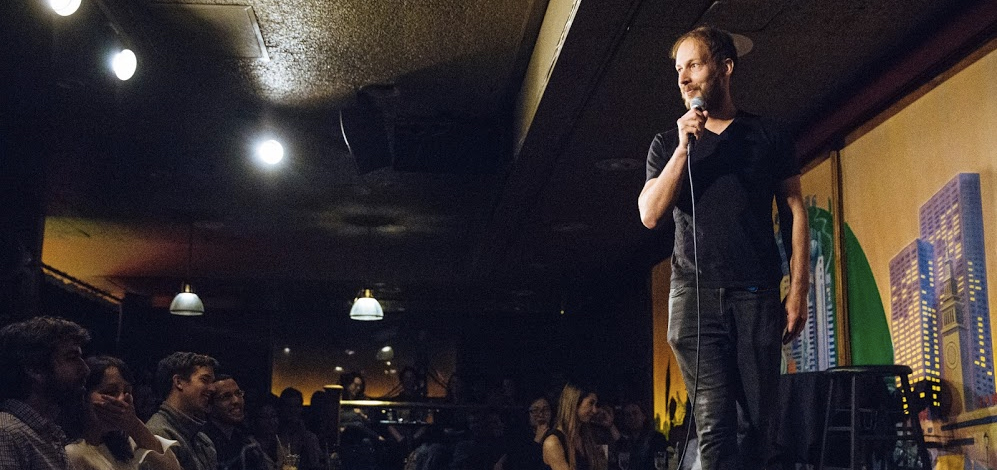An SF guide to starting out in standup comedy
An article that'll explain how standup comedy works and how you can try doing it.

One day I was on a flight—San Francisco to Los Angeles. There was a 10-year-old kid sitting next to me. At some point, I decided to break the ice and I asked the kid what he wanted to be. A standup comedian, he said. I then had an epiphany. I thought, standup comedians are actually hot. I'd been doing comedy for 2 years, and I completely forgot how trendy they were.
For the last 4 years, I've been running Comedy vs. Nerds. It's been a successful show, selling out each time, and people seem to love it. After the show, a lot of people ask me how I got into comedy and how they can try it. I tell them the same answer over and over again, and now I've finally realized that I can write an article about it and just refer them to it.
So if you're curious or thinking to try it, this article will explain how standup comedy works, what the scene in SF is like, and give you explicit steps on how to start.
For starting stand-up comedy, San Francisco is great. It offers a lot of stage time, probably somewhere right after NYC and LA. Also, compared to NYC and LA, San Francisco's community is friendlier and more supportive. In NYC, standup comics just don't have time—they do their set and leave for another set. In LA, everyone thinks they're a superstar—they won't talk to you unless you have 10k followers. But in SF, comics are down-to-earth, they'll stay and laugh at your jokes, they'll give you feedback if you ask for it. In SF, you can easily hit a few mics a night, and that's more than enough to start with.
How standup comedy works
In stand-up comedy, you want to write material that will reliably garner laughs each time you perform it. Yes, you can improvise funny jokes, but there is no guarantee you can come to a show and get 2 LPMs (laughs a minute) with just improvising. If you just want improvising, I'd recommend trying improv—a form of art that teaches you improvising on the spot. Standup comedy is all about the writing.
This is a simplified process comedy writing workflow, that comedians follow.
Writing material -> Testing material -> Refining material -> Testing material -> Refining material ...
"Writing material" is when you come up with the new material. Just write down things that you think are funny. Raw material doesn't have to be very funny. It just has to be something you can talk about. You can refine it later.
Once you have some material—let's say 3 mins of it—you can go to an open mic and "test" it. You basically tell your raw jokes to the audience and record your set. You have to test your material because it's quite common when a joke is funny to you, but other people don't get it. For example, when the audience doesn't understand the premise and you need to set it up better. Or when your references are not recognized.
Then, listen to your recorded set. Leave parts that got laughs, and remove or change parts that didn't get laughs. This is your homework—the "refinement". Once you've refined it, go try your refined material at an open mic.
Once you get 5-10 minutes of refined material, you can record a video of your set at an open mic and submit it to show producers—people who run stand-up shows in your area (when you start doing open mics you'll meet a lot of them).
After that, do more shows, record more videos, submit them to comedy festivals and, eventually, get your Netflix special! This is the 20k-foot view of how standup comedy works.
There are lots of books on writing jokes and their structure, look at this blogpost . But the best thing to do is to try.
San Francisco comedy scene
San Francisco has a lot of great open mics. My favorites are Edinburgh Castle and Under the buck. I also run an open mic called Comedy Spaceship @ Pianofight on Thursdays. Open mics are free. You're welcome to come by to any of those mics and observe comics working on their material. You'll see other people doing their set for the first time, veteran comics working on their new jokes. You'll see how supportive the community is and perhaps all that will inspire you to try as well.
There's a calendar that lists all open mics in the city.
Link: SF Calendar of Open Mics
It's well-maintained by SF's stand-up community.
Also if you started comedy and want to know what's going on in the community, there's Bay Area Comedy Network facebook group, where all bay area comics hang out.
One of the rituals for bay area comics is to come to what I call "SF's Comedy Temple" every Sunday—The Punchline. Every Sunday, they have an all-locals comedy show. At some point, they may put you on, which means you're on the right track.
SF's Comedy clubs
San Francisco has a lot of great comedy clubs. The most popular are
- "The Setup" a cozy hipster club in the basement with craft beer
- "The Punchline" a historic venue
- "Cobbs" 300 people club in the north beach
- "Cheaper than Therapy" a smaller venue in Nob Hill, but it's not covered by your health insurance.
Those clubs always get crowded. Besides these dedicated clubs, San Francisco has loads of other fun underground comedy shows that run everyday.
Summary, steps to start 👣
- Write 3-5 minutes of raw material.
- Pick an open mic (a list linked above)
- Perform and record audio
- Listen to the recording and refine your material
Good luck, and send me your netflix special once you make it big.
Also, like my page and share this post Michael Makarov
About the author
Michael Makarov is an NYC-based comic and a software engineer. He started his standup journey in 2014 in San Francisco, he sold out his first show in 30 minutes when the link made the top of Hacker News. Russian immigrant, he also speaks fluent Japanese and enough chinese to order food at restaurants. He runs Comedy vs. Nerds and Comedy Conspiracy, a standup comedy show about the internet. Other articles: 7x7 article
Latest Articles
- NFT is a Joke - How NFTs Can be Used for Stand-up Comedy
- Ideas To Make NYC the Best City on Earth
- Five Things I Enjoy the Most in Life
- New York City: Dead Forever (Until It’s Back)
- This Game Will Feel Like Being in a Comedy Club
- Live Stand-Up Comedy Works On Zoom And I Have A Video To Prove It 🚀
- What I've Learned Performing Stand-Up in 10 Countries
- Stand-Up Comedy In a Second Language
- How to put on a comedy show online using Zoom
- An SF guide to starting out in standup comedy
